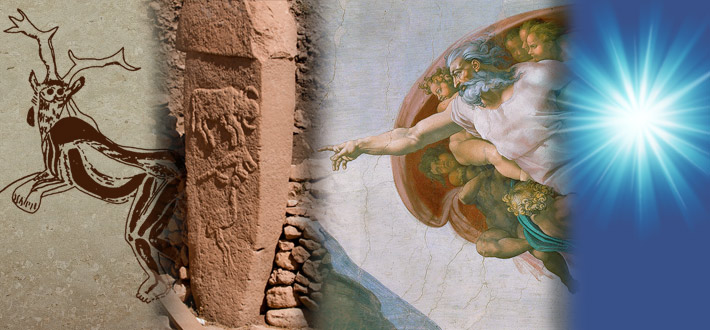
Connecting With the Gods
Neolithic Era
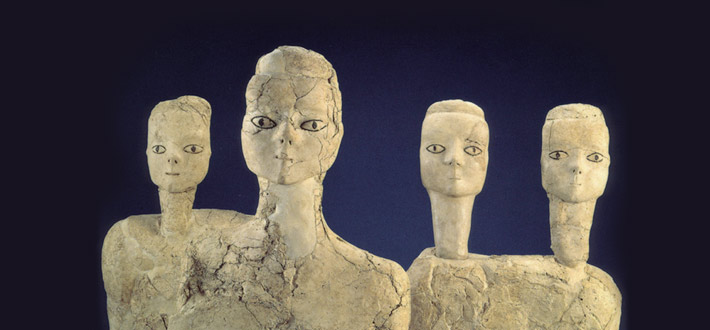
Neolithic Era: Cosmic and Terrestrial Maintenance
As the climate warmed, food sources became more plentiful and population numbers grew. An enormous communal effort and new inventions were required to assist and impress the spirit world to maintain cosmic and terrestrial harmony, and prevent a return of the perilous Ice Age.
Death and Transcendence
Shamans became the specialists in transcendence and the stability of the community rested on their ability to engage the whole group by connecting it to the spirit world. How would they do this?
Replicating the Cave Experience
Neolithic shamans no longer had to rely on the natural topography of each cave, but designed and built structures that repeated the cave experience.
Beliefs and Customs Journey West
As land became exhausted people were obliged to move to newer pastures.
Temples of Malta – A Scientific Breakthrough
At the foot of Sicily are two islands, Malta and Gozo, where more than 23 megalithic temples once stood. The construction of these temples spanned over a thousand years of continuous building and elaboration.
A Mega Building Boom as the Era Ends
In Britain about 1,300 Neolithic mega-sites appear to have been built within little more than a century.
Pyramids: Stairway to the Gods
Pyramid-shaped structures are yet another example of how human beings expressed their psychological understanding of our place in the universe as three-tiered.
Mesopotamia
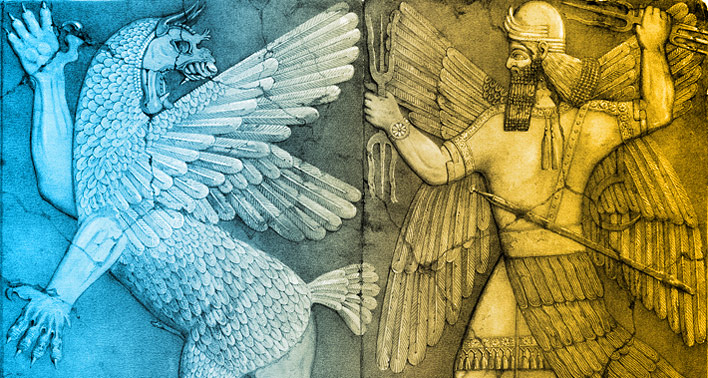
Mesopotamia: “The Land Between Two Rivers"
Part of the Fertile Crescent, Mesopotamia (“the land between the rivers” in Greek), was by its geographical location and development influential in the region from at least 2500 BCE to the fall of Babylon in 539 BCE.
Worldview and Beliefs
In the Mesopotamian worldview, illnesses and strife were caused by evil demons or by divine displeasure.
Connecting Heaven and Earth
The ziggurat, the “mountain of God” or “hill of Heaven” was the center of the temple complex. Built of clay bricks, it was a massive, solid, pyramidal stepped structure, the summit of which housed the God.
Early Signs of Monotheism
During the reign of Hammurabi in the 18th century BCE, Babylon became the principal city of southern Mesopotamia, and the patron deity of Babylon, the god Marduk, was elevated to the level of supreme god.
The Epic of Gilgamesh & Other Writings
In 1872, the Assyriologist George Smith astounded the London Society for Biblical Archaeology with the news that he had discovered on a cuneiform tablet an account of the Flood that was so similar to that of the biblical Book of Genesis that its influence could not be denied.
Understanding Their World
From their cuneiform writings on clay tablets scholars know that the Mesopotamians, like the later Greeks, attempted to understand their world and the universe in any way they could.
Noble Ones
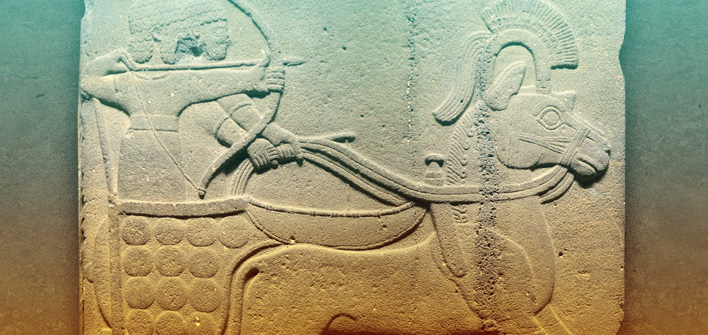
The Noble Ones
The Aryans or “Noble Ones” were thought to have remained together on the Caucasian steppes from about 4500 BCE until about 2500 BCE when groups began to migrate.
Indus-Sarasvati Civilization
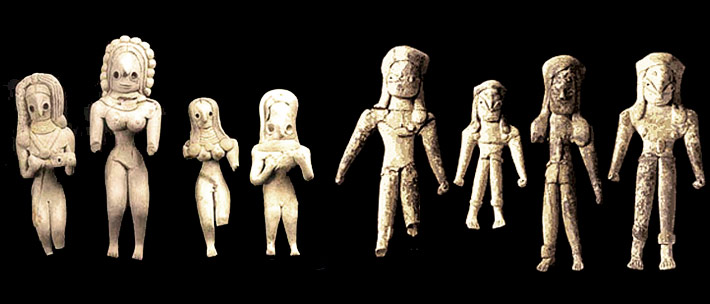
Indus-Sarasvati Civilization
By 2,500 BCE the Indus-Sarasvati or Harappan civilization became the largest civilization of the Ancient world, extending over more than 386,000 square miles across the plains of the Indus River from the Arabian Sea to the Ganges.
Mehrgarh 7000–2000 BCE
The Neolithic site of Mehrgarh is located to the west of the Indus-Sarasvati flood plain, in Baluchistan east of the mountain city of Quetta in Pakistan.
Harappa 3500–1900 BCE
Damage under Colonial rule and looting by local people likely set back our knowledge of this civilization.
Mohenjo-Daro 2600–1900 BCE
Located between the two vast river valleys of the Indus and the Sarasvati, Mohenjo-Daro was one of the most important cities of the Indus civilization.
The Demise of this Great Civilization
By about 3900 years ago (1900 BCE), the monsoons had shifted east causing the Sarasvati to gradually change from a perennial to a seasonal river.
Who Were They and What Did They Believe?
We know almost nothing of the Indus-Sarasvati people or their religion. Speculations on the meaning of figurines, depictions on seals, etc., are just that.
Aegean Neolithic and Bronze Age Civilizations
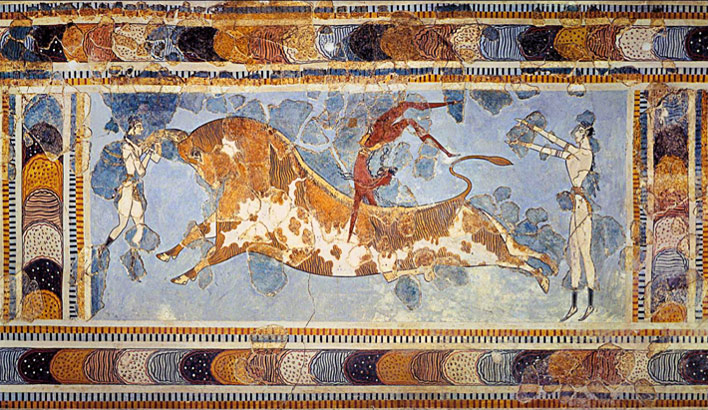
The Cycladic Civilization Circa 3300 to 1100 BCE
“There is a land called Crete, in the midst of the wine-dark sea, a fair, rich land, begirt with water, and therein are many men, past counting, and ninety cities...."
Minoa – Europe’s First Civilization ca 2000–1400 BCE
Crete sits at the crossroads of Africa, Asia, and Europe and was the hub of a cosmopolitan world that included Egypt, the Levant, Anatolia, and the Greek mainland.
Minoan “Palaces” and Religious Beliefs
In 1900, the famed archaeologist Sir Arthur Evans provided the first evidence of an extraordinary civilization. He named it Minoan, after the legendary King Minos, son of Zeus.
Conflict and Calamity
Earthquakes, often severe and ruinous, were frequent in Minoan times.
The Mycenaeans 1600–1100 BCE
The Mycenaeans were closely related to the Minoans - both descended from early farmers who lived in Greece and southwestern Anatolia.
The Bronze Age Collapse
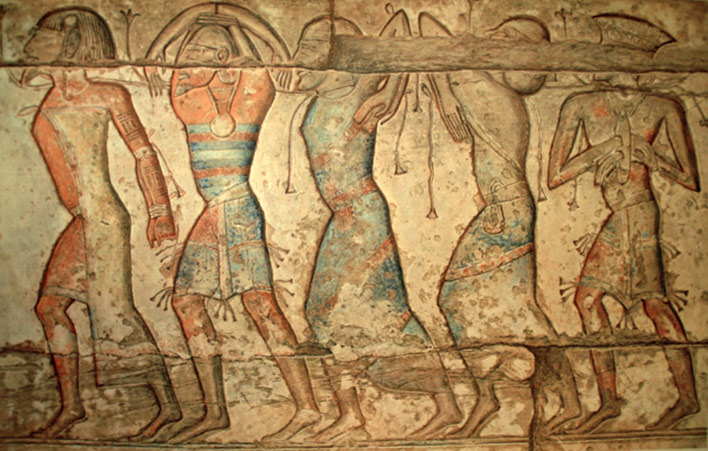
The First Global Economy
Could a series of catastrophes over a century or more, have led to the final collapse of the Bronze Age civilizations in the Aegean, Egypt, and the Near East after nearly two thousand years of growth and prosperity?
The Dark Ages
After nearly two thousand years of growth and prosperity, (ca 3000–1200 BCE) the civilizations in the Aegean, Egypt, and the Near East unraveled. What happened?
The Perfect Storm
Is what happened in the ancient world over 3,000 years ago likely to happen again, but on a much larger scale?
Archaic Greece

Archaic Greece: The Dark Age and a New Dawn
Evidence of very early settlement on the Greek Islands comes from the Franchthi cave, overlooking the Argolid Sea in the Peloponnese.
Emerging from the Dark Age 800–500 BCE
Statis or conflict was a continuous and ever present condition in the steps towards the polis or city-state – the political community which would become characteristic of Greece.
History According to the Storytellers
With no first handwritten documents of their past, survivors turned to traditional storytellers.
Religious Life
Like other pre-Axial cultures, Greeks believed in a pantheon of Gods who presided over every aspect of life and nature.
Ancient China

Early Civilizations China
Chinese civilization dates back 5,000 years to mythical and legendary individuals who ruled the fertile Yellow River valley of what we know today as China.
Three Legendary Sovereigns
Three Sage Kings, or Three August Ones, were said to be god-kings or demigods. Because of their superior virtue they lived to a great age and ruled over a long period of peace.
The Five Emperors
The Five Emperors may be thought of more as supreme beings, rather than “emperors.” They were morally perfect.
The Shang Dynasty 1600–1045 BCE
Historians note that the Shang dynasty was itself believed to be mythological until written evidence was found in the 1920’s.
“As the problems and challenges facing humankind have changed, so have their religious and ideological solutions. We live among the wreckage of once-potent solutions. If we neglect them, they may become barriers to thought and action. If we understand them, they are a treasure house for all of us to share.”
The Unseen World: The Rise of Gods and Spirits
The Institute for Cultural Research
